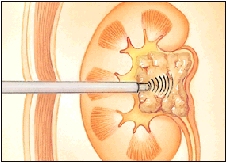Treating Kidney Stones: Percutaneous Nephrolithotomy
Treating Kidney Stones: Percutaneous Nephrolithotomy
Percutaneous nephrolithotomy may be done before, after, or instead of other treatments. If you need this procedure, your healthcare provider will discuss its risks and possible complications. You will be told how to prepare. And you will be told about medicine (anesthesia) that will keep you pain-free during treatment.
Nephrolithotomy with incision
Percutaneous nephrolithotomy removes larger stones through a small incision in your side. Your doctor places a viewing tube through your incision. The stone is sighted, shattered with a special device if needed, and removed. Afterward, you’ll briefly have a small soft tube in your incision. This tube carries urine away from your kidney and out of your body.
Your recovery
You may spend 1 day or 3 days in the hospital. The tube in your side will be removed during or shortly after your hospital stay. A follow-up visit in 3 months will ensure that your stone is gone. Later visits will help your healthcare provider spot new stones if any form.
When to call your healthcare provider
Contact your healthcare provider right away if you have:
Sudden pain or flank pain
A fever over 100.4°F (38°C)
Nausea that lasts for days
Heavy bleeding when you urinate or through your drainage tube
Swelling or redness around your incision
Updated:
March 21, 2017
Reviewed By:
Latif, Walead, DO,Walton-Ziegler, Olivia, MS, PA-C


